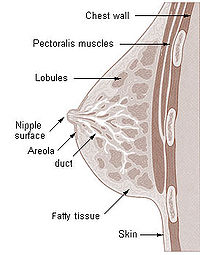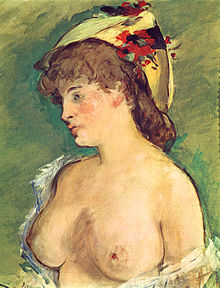Breast
HAVE YOU CHECKED THE CHILDREN GO SUCK A BUTTHOLE
The term breast, also known by the Latin mamma in anatomy, refers to the upper ventral region of an animal's torso, particularly that of mammals, including human beings. In addition, the breasts are parts of a female mammal's body which contain the organs that secrete milk used to feed infants.
This article focuses on human female breasts, but it should be noted that male humans also have breasts (although usually less prominent) and are born with the main milk ducts intact. While the mammary glands that produce milk are present in the male, they normally remain undeveloped. In some situations male breast development does occur, a condition called gynecomastia. Milk production can also occur in both men and women as a rare adverse effect of some medicinal drugs (such as some antipsychotic medication). Both sexes have a large concentration of blood vessels and nerves in their nipples.
Anatomy of the female breast

The breasts are covered by skin; each breast has one nipple surrounded by the areola. The areola is colored from pink to dark brown, hairless, and has several sebaceous glands. The larger mammary glands within the breast produce the milk; they consist of several lobules, and each breast has some 10-20 lactiferous ducts that drain milk from the lobules to the nipple, where each duct has its own opening,
Most of the breast is connective tissue, i.e., adipose tissue (fat) and Cooper's ligaments. The breasts sit over the pectoralis major muscle and usually extend from the level of the 2nd rib to the level of the 6th rib anteriorly. The superior lateral quadrant of the breast extends diagonally upwards in an 'axillary tail'. A thin layer of mammary tissue extends from the clavicle above to the seventh or eighth ribs below and from the midline to the edge of the latissimus dorsi posteriorly.
The arterial blood supply to the breasts is derived from the internal thoracic artery (previously referred to as the internal mammary artery), lateral thoracic artery, thoracoacromial artery, and posterior intercostal arteries. The venous drainage of the breast is mainly to the axillary vein, but there is some drainage to the internal thoracic vein.
The breast is innervated by the anterior and lateral cutaneous branches of the 4th through 6th intercostal nerves. The nipple is supplied by the T4 dermatome.
Lymphatic drainage
About 75% of lymph from the breast travels to the ipsilateral (same side) axillary lymph nodes. The rest travels to parasternal nodes, to the other breast, or abdominal lymph nodes. The axillary nodes include the pectoral, subscapular, and humeral groups of lymph nodes. These drain to the central axillary lymph nodes, then to the apical axillary lymph nodes. The lymphatic drainage of the breasts is particularly relevant to oncology, since cancer cells can break away from a tumour (breast cancer being a common cancer), and spread to other parts of the body through the lymph system by a process known as metastasis.
Function
The function of the mammary glands in female breasts is to nurture the young by producing milk, which emanates from the nipples during lactation. However, zoologists point out that no female mammal other than the human has breasts of comparable size when not lactating, and this suggests that the external form of the breasts is connected to factors other than lactation alone.
The mammary glands that secrete the milk from the breasts actually make up a relatively small fraction of the overall breast tissue. It is commonly assumed by biologists that the real evolutionary purpose of women having breasts is to attract the male of the species; that, in other words, breasts are a sexually dimorphic, or secondary sex characteristics. Some biologists (notably Desmond Morris) believe that the shape of female breasts evolved as a frontal counterpart to that of the buttocks, the reason being that whilst other primates mate in the typical piggy-back position, humans are more likely to successfully copulate mating face on. A secondary sexual characteristic on a woman's chest would have encouraged this in more primitive incarnations of the human race, and a face on encounter would have helped found a relationship between partners beyond merely a sexual one.
Others believe that the human breast evolved in order to prevent infants from suffocating while feeding[1]. Since human infants do not have a protruding jaw like our ancestors and the other primates, the infant's nose might be blocked by a flat female chest while feeding. According to this theory, as the human jaw became recessed, so the breasts became larger to compensate.
Size, shape and composition
Most of the human female breast is actually adipose tissue (fat) and connective tissue, rather than the mammary glands. There is naturally a great variety in the size and shape of breasts in women (and men), with size being affected by various factors including genetics.
| File:Breasts1205.jpg |
| File:Breasts1.jpg |

|

|
The primary anatomical support for the breasts is thought to be provided by the Cooper's ligaments, with additional support from the skin covering the breasts themselves, and it is this support which determines the shape of the breasts. The breasts naturally sag through ageing, as the ligaments become elongated. This process may be accelerated by high impact exercises, and a brassiere may reduce this effect by providing external support, although the health benefits of wearing of a brassiere are not universally accepted. Sagging breasts (ptosis) are considered undesirable by some, and some older women seek cosmetic surgery to raise their busts.
As breasts are mostly composed of adipose tissue, their size can change over time if the woman gains or loses weight. It is also typical for them to grow in size during pregnancy and whilst breastfeeding, mainly due to hypertrophy of the mammary gland in response to the hormone prolactin. The size of a woman's breasts usually fluctuates during the menstrual cycle, particularly with premenstrual water retention. An increase in breast size is also a common side effect of use of the contraceptive pill.
There is no relationship between breast size and ability to breastfeed, and it is a common misconception that human female breasts are shaped the way they are so that they can feed babies by producing milk. Their shape is thought to have evolved due to sexual attraction, as described above.
The size of a woman's breasts is typically expressed as a "bra size". According to the results of the "Size UK" survey [2], the average bra size in the UK has increased from a 34B in the 1950s to a 36C today, and the average size for U.S. women is a 34B as of 2005 by the CDC. Women with exceptionally large breasts may experience back pain, whilst in some Western societies there is a belief amongst some that small breasts make a woman less sexually attractive. Some women suffer from insecurity about their breasts, and in some cultures a number of women who are unhappy with their size seek surgery either to artificially reduce or enlarge their breasts. The American Society for Aesthetic Plastic Surgery found that 334,052 breast augmentation procedures were performed in 2004 [3]. Some women undergo breast reconstruction after mastectomy for breast cancer, a result of the high value placed on symmetry of the female human form in those cultures, and because women often identify their femininity and sense of self with their breasts.
It is typical for a woman's breasts to be unequal in size (statistically it is slightly more common for the left breast to be the larger), particularly whilst the breasts are developing during puberty. In some rare cases, one breast may be greatly larger or smaller than the other, or fail to develop entirely.
Development
The development of a woman's breasts, during puberty, is caused by sex hormones, chiefly estrogen. This hormone has been demonstrated to cause the development of woman-like, enlarged breasts in men, a condition called gynecomastia, and is sometimes used deliberately for this effect in male-to-female sex reassignment surgery.
A number of medical conditions are known to cause abnormal development of the breasts during puberty. Virginal breast hypertrophy is a condition which involves excessive growth of the breasts during puberty, and in some cases the continued growth beyond the usual pubescent age. Breast hypoplasia is a condition where one or both breasts fail to develop during puberty.
The orb-like shape of breasts help limit heatloss, as a fairly high temperature is required for the production of milk.
Terminology
- For slang terms for the breasts, see WikiSaurus:breasts
A brassiere (from French, lit: arm-holder) or bra is an item of women's underwear consisting of two cups that totally or partially cover the breasts for support and modesty.
Being topless is the state of having bare breasts.
Cultural status

Historically, breasts were regarded as fertility symbols, due to the belief that milk is life-giving. Ancient statues of goddesses—so-called Venus figurines—often emphasised the breasts, as in the example of the Venus of Willendorf. In historic times, goddesses such as Ishtar were shown with multiple breasts, alluding to their role as goddesses of childbirth.
Breasts are considered as secondary sex characteristics, and are sexually sensitive in many cases. Bare female breasts can elicit heightened sexual desires from men and women. Since they are associated with sex, in many cultures bare breasts are considered indecent, and they are not commonly displayed in public, in contrast to male chests. Other cultures view the baring of breasts as acceptable, and in some countries women have never been forbidden to bare their chests. Opinions on the exposure of breasts is often dependent on the place and context, and in some Western societies, exposure of breasts on a beach may be considered acceptable, although in town centres, for example, it is usually considered indecent.
In some cases, their display may be interpreted as indecent or sexual, even when they are being used for their primary purpose of nursing offspring. This has led, in several cases, to women being arrested for indecent exposure for breastfeeding their children in public.
Women in some areas and cultures are approaching the issue of breast exposure as one of sexual equality, since men (and pre-pubescent children) may bare their chests, but women and teenage girls are forbidden. In the United States, the Topfree equality movement seeks to redress this imbalance; this movement has won a decision in 1992 in a New York Court of Appeals which seems to substantially support their assertions. A similar movement succeeded in most parts of Canada in the 1990s. In Australia it is acceptable for women and teenage girls to sunbathe topless on some public beaches, but these are generally the only public areas where exposing breasts is acceptable.
In some cultures, breasts must always remain covered for religious reasons, for example, Islamic cultures forbid exposure of the female breasts.
In addition to the above references, see also modesty, nudism and exhibitionism.
Disorders of the breasts
Infections and inflammations
- Other infections
- Inflammations
Benign breast disease
- Aberrations of normal development and involution
- fibroadenomatosis
- cyclical nodularity
- cysts
- fibroadenoma - benign tumor
- Pregnancy-related
Malignant breast disease
- Breast cancer (mammary carcinoma)
- Carcinoma in situ
- Paget's disease of the nipple, also known as Paget's disease of the breast
See also
- Breastfeeding
- Breast fetishism
- Breast implant
- Breast reconstruction
- Gynecomastia
- intimate parts
- Topfree equality
- Mammary intercourse
- Puberty
External links
- Stages of breast development, from Puberty101
- 007 Breasts — a website promoting the view that breasts should not be considered sexual
